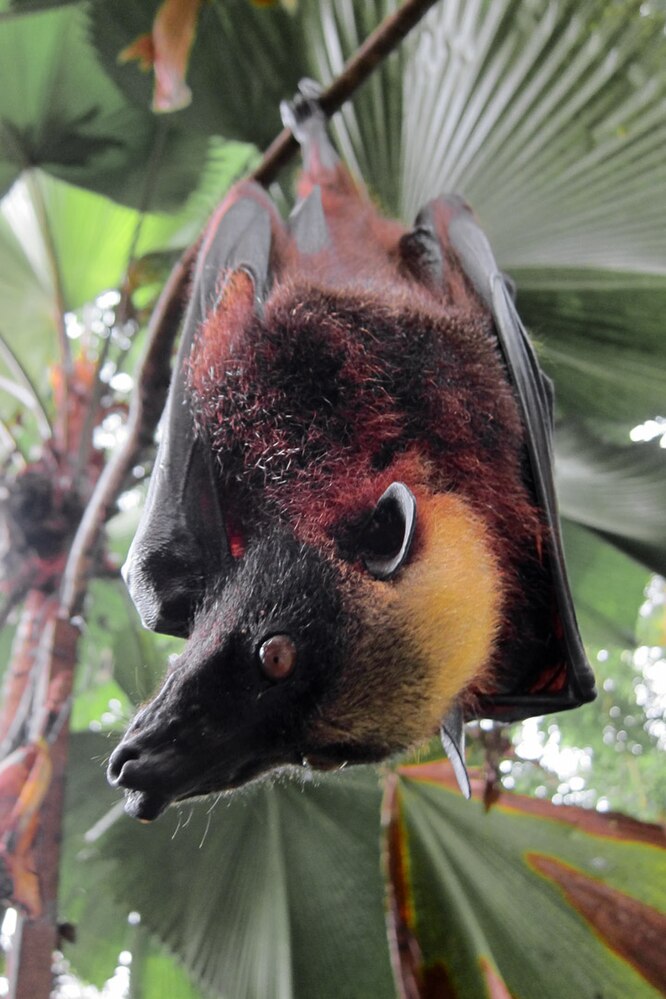How many baby Giant golden-crowned flying foxs are in a litter?
A Giant golden-crowned flying fox (Acerodon jubatus) usually gives birth to around 1 babies.With 1 litters per year, that sums up to a yearly offspring of 1 babies.
Upon birth, they weight 13 grams (0.03 lbs). They are a member of the Pteropodidae family (genus: Acerodon).
To have a reference: Humans obviously usually have a litter size of one ;). Their babies are in the womb of their mother for 280 days (40 weeks) and reach an average size of 1.65m (5′ 5″). They weight in at 62 kg (137 lbs), which is obviously highly individual, and reach an average age of 75 years.

The giant golden-crowned flying fox (Acerodon jubatus), also known as the golden-capped fruit bat, is a species of megabat endemic to the Philippines. Since its description in 1831, three subspecies of the giant golden-crowned flying fox have been recognized, one of which is extinct. The extinct subspecies (A. jubatus lucifer) was formerly recognized as a full species, the Panay golden-crowned flying fox. Formerly, this species was placed in the genus Pteropus; while it is no longer within the genus, it has many physical similarities to Pteropus megabats. It is one of the largest bat species in the world, weighing up to 1.4 kg (3.1 lb)—only the Indian and great flying fox can weigh more. It has the longest documented forearm length of any bat species at 215 mm (8.5 in).It is primarily frugivorous, consuming several kinds of fig. However, its diet also includes some leaves. It forages at night and sleeps during the day in tree roosts. These roosts can consist of thousands of individuals, often including another species, the large flying fox. Not much is known about its reproduction; it gives birth annually from April through June, with females having one pup at a time. Predators of the giant golden-crowned flying fox include raptors such as eagles, the reticulated python, and humans.Owing to deforestation and poaching for bushmeat, it is an endangered species. Though national and international law makes hunting and trade of this species illegal, these regulations are inadequately enforced, meaning that the species is frequently hunted nonetheless. Even in roosts that are more stringently protected from poaching, it is still affected by human disturbance via tourists who intentionally disturb them during the day.
Other animals of the family Pteropodidae
Giant golden-crowned flying fox is a member of the Pteropodidae, as are these animals:
- Veldkamp’s dwarf epauletted fruit bat weighting only 21 grams
- Blanford’s fruit bat weighting only 28 grams
- Island tube-nosed fruit bat weighting only 107 grams
- Cave nectar bat with 1 babies per pregnancy
- Leschenault’s rousette with 1 babies per pregnancy
- Peters’s epauletted fruit bat weighting only 95 grams
- Moss-forest blossom bat weighting only 20 grams
- Gambian epauletted fruit bat weighting only 131 grams
- Angolan epauletted fruit bat with 1 babies per pregnancy
- Black-eared flying fox with 1 babies per pregnancy
Animals that share a litter size with Giant golden-crowned flying fox
Those animals also give birth to 1 babies at once:
- Narwhal
- Bechstein’s bat
- Kob
- Sooty mustached bat
- Brazilian brown bat
- Cantor’s roundleaf bat
- Moustached tamarin
- Moonrat
- Shining thicket rat
- Desert long-eared bat
Animals with the same weight as a Giant golden-crowned flying fox
What other animals weight around 1.09 kg (2.4 lbs)?
- Ashy black titi weighting 992 grams
- Menzies’ echymipera usually reaching 1.2 kgs (2.65 lbs)
- Green acouchi weighting 966 grams
- Bahamian hutia weighting 912 grams
- Greater glider usually reaching 1.26 kgs (2.78 lbs)
- American marten weighting 878 grams
- Coppery titi usually reaching 1.12 kgs (2.47 lbs)
- Malagasy giant rat usually reaching 1.18 kgs (2.6 lbs)
- Eastern lowland olingo usually reaching 1.24 kgs (2.73 lbs)
- Eastern barred bandicoot weighting 903 grams
